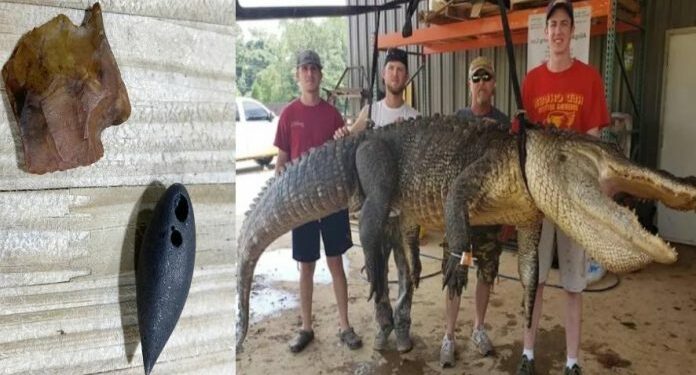Shane Smith of Red Antler Processing in Yazoo City, Mississippi, inspected the guts of alligators sent to him for butchering this year.
He’d heard stories from other butchers about unusual findings in alligator bellies and wanted to see for himself. Then, he discovered of a lifetime.
In September, Smith discovered prehistoric Indigenous American antiquities within the gut of a 750-pound alligator.
According to CNN, Smith meticulously collected these items and photographed them for a Facebook post that drew James Starnes’ attention. He promptly identified the artifacts as hunting gear dating as far back as 6000 B.C. as the director of Surface Geology and Surface Mapping for Mississippi’s Department of Environmental Quality.

The other thing looked like a shattered arrowhead. It is, however, an “atlatl dart point,” an ancient spear- or dart-like device with a sharpened stone tip at the base that dates to roughly 6000 B.C. and is used in prehistoric hunts. Starnes knew precisely where they came from.
“We’ve had Native American occupants in North America for at least 12,000 years, notably in Mississippi,” he stated. “This is the technology they would have carried along with them.” These items were created before introducing bows and arrows in North America.”
That confirmation left Smith with only one question: how did these objects find up in an alligator’s stomach?
Smith’s adventure began when he read an article in the spring about a South Carolina wild game processor who discovered dog tags in an alligator’s stomach. Smith began to investigate all of his company’s larger specimens from then on, and he soon found two objects amid the bones, hair, feathers, and stones.

He described the scene as “everyone standing around like I was opening a Christmas present.” “We just threw everything in a bin.” When I turned around, I noticed a rock with a distinctive hue. The arrowhead was the culprit. It was merely astonishment. He couldn’t possibly have had an arrowhead.”
“You naturally assume, ‘Oh, my gosh, this alligator either ate an Indian or an animal shot by the Indian.’ But, you know, the alligator is not thousands of years old,” he remarked.
“We laughed about it and joked that I was probably the only person on the planet who could take an arrowhead from an alligator’s gut.”
Starnes quickly clarified that the object in question was not an arrowhead. Atlatl dart tips, used to propel spears, are made up of numerous parts. The tool used lever technology to boost the projectile’s velocity, with a pointed stone at the base and a piece of wood with a cup on the other end.
Starnes explained, “That’s an atlatl dart point.” “People mistakenly believe that all heads are arrowheads, but they would be the tiny points.”
Starnes was able to date the perplexing drop to around 1700 B.C. during the Late Archaic Period. While the sight of two holes led Smith to believe it was a fishing weight, the holes do not run through the object, leaving its usage a mystery. It’s also not manufactured with Mississippi-grown materials.

“We have no notion what the plummets were used for,” he explained. “These items had some significance, but we don’t know what it was. We can only speculate.”
In the end, it’s more of a mystery how Indigenous Americans utilized the plummets than how one ended up in an alligator’s belly. These animals hoover up anything from boulders as large as a silver dollar to aid digestion. Stones remain in the alligators’ stomachs because their bodies cannot digest them.
“Artifacts appear in some extraordinary places because this area was so densely occupied over such a long period,” Starnes explained.
“You could imagine one of these sites with this much stone stuff eroding out of the bank, relatively simple pickings for an alligator, especially looking for her, simply something to eat.” “Alligators consume just about anything.”























